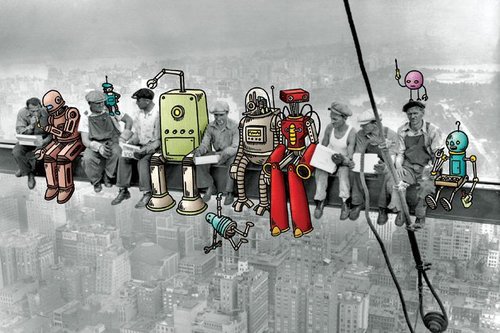
10/01/2015
People in the business of adding automation and subtracting humans from the workplace claim to be concerned about whether the remaining humans are happy with the arrangement. Certainly companies want customers to be comfortable when in direct contact with smart machines, but the opinion of average workers probably counts for sub-zero in the big offices.One of the companies mentioned in the article below is Amazon, which has been expanding robotics in processing items to be shipped to customers from ultra-modern warehouses. Below is a tour of the company’s newish Robbinsville NJ “fulfillment center” that covers 1.2 million square feet — around 27 acres.
Humans are still an important part of the process, largely because of the manual dexterity needed to pick up all shapes of objects and pack them into boxes. But robot engineers are working on a machine for that, spurred on by the company-sponsored competition, the Amazon Picking Challenge. The Hitachi packing robot has advanced dexterity skills, and may be the next step to a completely automated warehouse.
Below, Kiva robots operate from a computer system that tracks and moves everything in the warehouse. They scoot under mobile racks of merchandise and move needed items to packing stations run by humans.

Automation, software and robots are improving at breakneck speed, increasing in capabilities that would have been thought to be science-fiction a few years ago.
A 2013 investigation by the Associated Press found that good jobs lost in the economic downturn aren’t coming back: Millions Of Middle-Class Jobs Killed By Machines In Great Recession’s Wake. Companies chose to become more “efficient” by laying human workers off and substituting smart machines for a range of employment from farm pickers to educated office workers.
Experts see even more jobs lost, such as the 2013 Oxford University study that predicted nearly half of US employment was vulnerable to machine replacement in 20 years. During a Labor Day interview on CBS News, NYU Professor Gary Marcus remarked, “Eventually I think most jobs will be replaced, like 75 or 80 percent of the people are not going to work for a living.”
Nevertheless, automatic immigration continues along as if the workplace weren’t fundamentally changing. Washington is snoozing through this sea change, with no debate about the shrinking need for workers. Given the increasingly automated future, the correct number of immigrant workers is ZERO.
Are You Ready for a Robot Colleague?, MIT Technology Review, By Will Knight, September 28, 2015Robots are moving into new areas of work, and it isn’t entirely clear how staff and customers will react.
Those who work in professions from warehouse staff to hotel concierges may soon count a robot among their colleagues.
While Amazon has pioneered the use of robots in its fulfillment centers, its robots are still largely separated from human workers (see “Inside Amazon”). The next generation of workplace bots will work in much closer proximity to regular employees. Some will replace workers entirely, but most will simply take on the more mundane tasks of a human’s job.
Clearpath Robotics, a company based in Ontario, Canada, launched a robotic platform designed to take on the work done by forklift truck drivers in warehouses and factories. The company’s system, called Otto, was on show at the RoboBusiness conference in San Jose, California, last week. Several companies are testing the system, including GE, which has also invested in Clearpath.
Otto first must be driven through a warehouse, so that its laser sensors can map the environment. The user can then load the system with heavy items and command it to go from one part of the warehouse to another. And Otto will navigate around obstacles, including people, as it goes.
Another new robot on display at the show, from a company called Fetch Robotics, based in San Jose, will follow warehouse workers around with a bin, helping them retrieve items from shelves. Once a bin has been filled, the robot will roll away, and another will take its place.
Melonee Wise, founder of Fetch, says careful thought needs to be put into the way other workers will react to a robot (see “Innovators Under 35: Melonee Wise”). “So it’s in our best interest to make that interaction as smooth and enjoyable as possible,” she says. “If they don’t want to work with our product, then no matter how good it is, it isn’t going to make it very far.”
Another version of Fetch’s robot has a torso and a single arm at its center. That robot is meant to take the place of a human worker, retrieving products in concert with a bin-carrying bot.
Human-robot interaction, which has been a theme in academic research for some time, is now becoming more commercially relevant. Wise says, for example, that research has shown that a certain shape of head can be intimidating, and that a voice interface can encourage a particular type of interaction. “When robots talk, it conveys a certain level of intelligence, and people start thinking the robot is smarter than them, so they’re less likely to help the robot,” she says. “When the robot has nonverbal cues, people are much more willing to help out.”
Other robot startups have discovered odd challenges with robots designed to work closely with people.
A company called Fellow Robots, based in San Jose, has developed a mobile system that offers to help customers in a store. The armless, rectangular, wheeled robot is currently being tested at a nearby hardware store and at a few undisclosed locations. The system circles the store, and customers can use it to search for products, either by voice or via a touch screen. Once it has found an item, it will lead a customer to the correct location.
This is a content archive of VDARE.com, which Letitia James forced off of the Internet using lawfare.